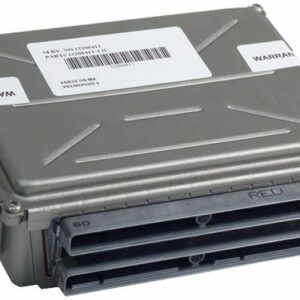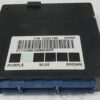Restore Peak Performance to Your GM Truck or SUV
If you’re dealing with frustrating issues like a persistent Check Engine Light, erratic shifting, stalling, or poor fuel economy in your vehicle, a failing Powertrain Control Module (PCM) is often the culprit. As the brain of your engine and transmission, its proper function is critical. This replacement PCM, part number 9354896, is the definitive solution to restore your vehicle’s reliability and drivability. I’ve seen firsthand in my 20+ years of diagnostic work how a faulty computer can cause a cascade of problems that are otherwise impossible to trace.
We take the guesswork and hassle out of the repair. Unlike a generic module from a parts store, this unit comes fully programmed to your vehicle’s specific Vehicle Identification Number (VIN). We load the latest GM factory software updates before it ships, ensuring optimal performance, fuel efficiency, and emissions compliance right out of the box. This simple, direct-fit solution saves you a costly trip to the dealership for programming.
Is Your Vehicle Exhibiting These Symptoms?
A failing engine computer can manifest in numerous ways. If you’re experiencing any of the following, it’s a strong indicator that your PCM needs attention. In my shop, these are the classic signs we look for when diagnosing a bad module.
- ✔ Unexplained Check Engine Light (CEL) illumination
- ✔ Stalling, hesitation, or rough idling
- ✔ Harsh or erratic automatic transmission shifting
- ✔ Complete no-start or intermittent starting problems
- ✔ Noticeable decrease in fuel mileage
- ✔ Failure to pass an emissions or smog test
- ✔ Communication error codes, such as the dreaded P0601 (Internal Control Module Memory Check Sum Error)
Case Study: A Tricky Diagnosis
A customer brought in a 2000 Silverado 2500 with an intermittent no-start condition that two other shops couldn’t solve. The truck would run fine for weeks, then refuse to start for a day. There were no consistent trouble codes. After checking all the basics—fuel pressure, spark, battery connections—I focused on the 2000 Yukon XL Powertrain Control Module‘s cousin in this truck. By monitoring data streams during a crank/no-start event, I saw the PCM wasn’t commanding the fuel pump relay on. We swapped in a known-good, programmed PCM, and the problem vanished. The original module had an internal hairline fracture on the circuit board that would separate when the engine bay temperature changed just right. It’s a classic example of how a PCM can fail without throwing a clear code.
A Straightforward Guide to Installation
Replacing the PCM on most of these GM trucks and SUVs is a job most DIYers can handle with basic hand tools. The key is taking your time and being careful with the electrical connectors. After installation, a simple security relearn procedure is typically required, which does not need a scan tool.
- Safety First: Disconnect the negative terminal from your vehicle’s battery to prevent any electrical shorts.
- Locate the PCM: On most trucks like the Yukon, Tahoe, and Silverado, the PCM is located under the hood on the driver’s side, below or next to the battery tray. On F-body cars like the Camaro and Firebird, it’s typically behind the passenger-side strut tower.
- Disconnect Connectors: Carefully unclip and remove the large electrical harness connectors from the old module. Inspect them for any corrosion or damaged pins.
- Remove the Old Module: Unbolt the mounting bracket holding the old PCM in place and remove it from the vehicle.
- Install the New Module: Mount your new, pre-programmed PCM in the same location and securely fasten it.
- Reconnect Everything: Firmly press the harness connectors into the new module until they click into place. Reconnect the negative battery terminal.
- Perform Security Relearn: Turn the key to the ‘ON’ position (without starting) for 10-15 minutes. The ‘Security’ light on the dash should turn off. Turn the key off for 10 seconds, then repeat this cycle two more times. After the third cycle, the vehicle should start and run normally.
Verified Vehicle Compatibility
This module is a direct replacement for part numbers 9354896, 09354896, and 19109040. It is guaranteed to fit the following vehicles. Please provide your VIN upon purchase to ensure we provide a perfectly matched and programmed 2000 Yukon XL Powertrain Control Module or the correct file for your specific model.
- CAMARO: 1999-2002 (5.7L)
- CORVETTE: 1999-2000
- FIREBIRD: 1999-2002 (5.7L)
- SIERRA 1500 PICKUP: 1999-2000 (V8)
- SIERRA 2500 PICKUP: 1999-2000
- SILVERADO 1500 PICKUP: 1999-2000 (V8)
- SILVERADO 2500 PICKUP: 1999-2000
- SUBURBAN 1500: 2000
- SUBURBAN 2500: 2000
- TAHOE: 2000 (Silverado style)
- YUKON: 2000 (exc. Denali)
- YUKON XL 1500: 2000
- YUKON XL 2500: 2000
Frequently Asked Questions
Why do you need my VIN?
Your Vehicle Identification Number (VIN) allows us to access the exact factory calibration file for your specific vehicle. This includes engine size, transmission type, axle ratio, and tire size. Programming with your VIN ensures the module works perfectly with your vehicle’s systems, just like the original one did.
Is this a plug-and-play part?
Yes, for the most part. Because we pre-program it to your VIN, you will not need a dealer-level scan tool for software flashing. However, you will need to perform a simple ‘security relearn’ procedure after installation, which involves cycling the ignition key and takes about 30 minutes. Instructions are included.
Will this fix my transmission shifting problems?
In many cases, yes. The PCM controls both the engine and the transmission. If the module has internal faults, it can cause erratic shifting, delayed engagement, or incorrect gear selection. If your transmission issues are electronic in nature, this module is a very likely solution.
What if my part number is slightly different?
This module, 9354896, also directly replaces part numbers 19109040 and 09354896. If your part number is not listed, please contact us. We can verify compatibility to ensure you get the correct computer for your vehicle.
Do I need any special tools to install this?
No special tools are required. Basic hand tools, such as a socket set and ratchet, are all that’s needed to physically replace the module. The security relearn procedure does not require any tools at all.



